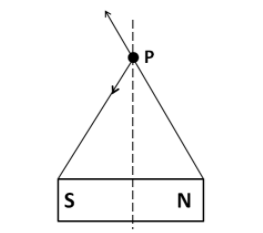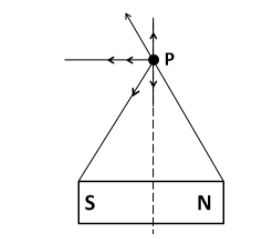
Direction of magnetic field at equatorial point is:
(A) Parallel to $\vec M$
(B) Perpendicular to $\vec M$
(C) Making an angle of $45$ with $\vec M$
(D) Anti-parallel to $\vec M$
Answer
220.2k+ views
Hint: To solve this question, we need to consider a magnetic dipole and find out the direction of the magnetic field from the vector addition rule. The magnetic field is always directed away from the north pole and towards the south pole.
Complete step-by-step answer:
Let us consider a magnetic dipole as shown in the figure below.

We consider a point P at the equatorial position of the dipole. We know that the magnetic field lines from the South Pole always come towards it, while they are directed away from the North Pole. So the magnetic field lines are shown in the below figure.

Now, we take the components of these fields along directions parallel and perpendicular to the dipole axis, as shown in the below figure.

Now, as the point P is located symmetrically with respect to both the North Pole and the South Pole, the fields produced by both of them at P have the same magnitude.
As we can see in the above figure that the vertical components oppose each other. As they are equal, they will cancel each other.
Also, we see that the horizontal components are parallel. So they get added together and hence the net magnetic field at P is parallel to the axis of the dipole.
We know that the direction of the dipole moment $\vec M$ is directed from the North Pole to the South Pole. The net magnetic field is also parallel to the direction from the North to the South Pole.
Thus, the magnetic field at the equatorial point is parallel to $\vec M$.
Hence, the correct answer is option A.
Note: For finding out the magnitude of the magnetic field at the axial and the equatorial positions of a dipole, we can use the analogy between the electric and the magnetic fields. The South Pole will be equivalent to a negative charge, and the North Pole will be equivalent to a positive charge.
Complete step-by-step answer:
Let us consider a magnetic dipole as shown in the figure below.

We consider a point P at the equatorial position of the dipole. We know that the magnetic field lines from the South Pole always come towards it, while they are directed away from the North Pole. So the magnetic field lines are shown in the below figure.

Now, we take the components of these fields along directions parallel and perpendicular to the dipole axis, as shown in the below figure.

Now, as the point P is located symmetrically with respect to both the North Pole and the South Pole, the fields produced by both of them at P have the same magnitude.
As we can see in the above figure that the vertical components oppose each other. As they are equal, they will cancel each other.
Also, we see that the horizontal components are parallel. So they get added together and hence the net magnetic field at P is parallel to the axis of the dipole.
We know that the direction of the dipole moment $\vec M$ is directed from the North Pole to the South Pole. The net magnetic field is also parallel to the direction from the North to the South Pole.
Thus, the magnetic field at the equatorial point is parallel to $\vec M$.
Hence, the correct answer is option A.
Note: For finding out the magnitude of the magnetic field at the axial and the equatorial positions of a dipole, we can use the analogy between the electric and the magnetic fields. The South Pole will be equivalent to a negative charge, and the North Pole will be equivalent to a positive charge.
Recently Updated Pages
Electricity and Magnetism Explained: Key Concepts & Applications

JEE Energetics Important Concepts and Tips for Exam Preparation

JEE Isolation, Preparation and Properties of Non-metals Important Concepts and Tips for Exam Preparation

JEE Main 2021 July 25 Shift 1 Question Paper with Answer Key

JEE Main 2021 July 22 Shift 2 Question Paper with Answer Key

States of Matter Chapter For JEE Main Chemistry

Trending doubts
JEE Main 2026: Application Form Open, Exam Dates, Syllabus, Eligibility & Question Papers

Understanding Uniform Acceleration in Physics

Derivation of Equation of Trajectory Explained for Students

Hybridisation in Chemistry – Concept, Types & Applications

Understanding the Angle of Deviation in a Prism

How to Convert a Galvanometer into an Ammeter or Voltmeter

Other Pages
JEE Advanced Marks vs Ranks 2025: Understanding Category-wise Qualifying Marks and Previous Year Cut-offs

Dual Nature of Radiation and Matter Class 12 Physics Chapter 11 CBSE Notes - 2025-26

Understanding Centrifugal Force in Physics

JEE Main Marking Scheme 2026- Paper-Wise Marks Distribution and Negative Marking Details

Degree of Dissociation: Meaning, Formula, Calculation & Uses

Ideal and Non-Ideal Solutions Explained for Class 12 Chemistry




